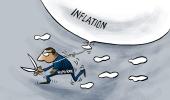Bond markets, global as well as domestic, are likely headed towards hard times over the next three to six months, as higher vegetable prices, rising fuel costs, and improved wages may keep inflation hot, believe analysts, who expect the yields to hit 7.5 per cent in the near-term from the current 7.234 per cent.

In this backdrop, they suggest investors can put in money in funds/instruments with residual maturity of 4 to 6 years, while longer-term investors can allocate cautiously to the longer end in the range beyond 7 years.
"10-year bond yields may rise up to 7.30 per cent in the near term, but soften thereafter, by 25-40 basis points, in one year.
"Investors may consider putting money in the short-to-medium term debt funds," said Devang Shah, co-head of fixed income at Axis Mutual Fund.
According to the data provided by Association of Mutual Funds in India (AMFI), debt funds saw net inflow of Rs 61,440.08 crore in the month of July as against net outflow of Rs 14,135.52 crore in June.
Rising yields
Over the past one month, the yields on 10-year government bonds have risen 14.7 basis points to 7.218 per cent in India, while they have touched a 17-year high of 4.35 per cent in the US, surging 50.8 basis points during the period amid a hawkish US Fed.
Yields on short-term bonds back home, analysts believe, may also harden as liquidity remains tight, especially after the RBI mandated all scheduled banks to maintain an incremental cash reserve ratio (I-CRR) of 10 per cent on the increase in their net demand and time liabilities (NDTL) between May 19, 2023 and July 28, 2023, with effect from August 12.
Following the move, surplus liquidity has dried up to Rs 53,800 crore as of August 20, against Rs 2.6 trillion on August 10 - the day of the RBI policy announcement.
Yields on the one-year, and two-year government bonds have inched up 8 bps and 4 bps, respectively, since August 10.
"The coming three-to-six months will be critical for the bond markets.
"We expect yields on 10-year G-Sec to move up to 7.50 per cent in the near-term on the back of inflationary pressure from vegetable prices, electricity tariff hike, and rural wage growth.
"We believe these triggers may push the Reserve Bank of India towards a surprise rate hike," said Swati Singh, executive director and head of fixed income at Avendus Wealth Management.
During the August policy, the Monetary Policy Committee (MPC) of the RBI kept the repo rate unchanged at 6.5 per cent for a third consecutive policy, looking through the transient vegetable inflation.
The central bank, however, revised upwards its inflation projections for financial year 2023-24 (FY24) to 5.4 per cent (earlier 5.1 per cent).
Projections for the second (Q2) and third (Q3) quarters of FY24 also saw a sharp revision to 6.2 per cent (5.4 per cent earlier) and 5.7 per cent (5.4 per cent earlier).
Meanwhile, the consumer price index (CPI)-based inflation surged to 7.44 per cent in July, highest since April 2022.
Moreover, it was the first time since September 2022 that price rise has been over 7 per cent.
Vegetable prices soared 37.3 per cent, while the price of cereals and pulses basket surged 13 per cent, taking the food inflation basket for urban consumers higher by 12.3 per cent and 11 per cent for rural consumers, as per the National Statistical Office.
“India’s 10-year yield has gained considerable momentum post upside surprise in the CPI data, and could likely touch 7.3 per cent-mark over the next one month,” Dipanwita Mazumdar, economist at Bank of Baroda, said in a note.
Currently, the 10-year yield differential between India and US, Mazumdar added, is at 312bps.
“Historically, the difference between the two has been around 400bps; so, there is a possibility that the difference might tend towards the mean reverting level.
"In that case, India’s 10-year yield must rise at a faster pace compared to the US.
"However, this seems unlikely unless inflation surprises on the upside throughout Q2, which might prompt RBI to have a hawk-eyed view on rates,” she said.











